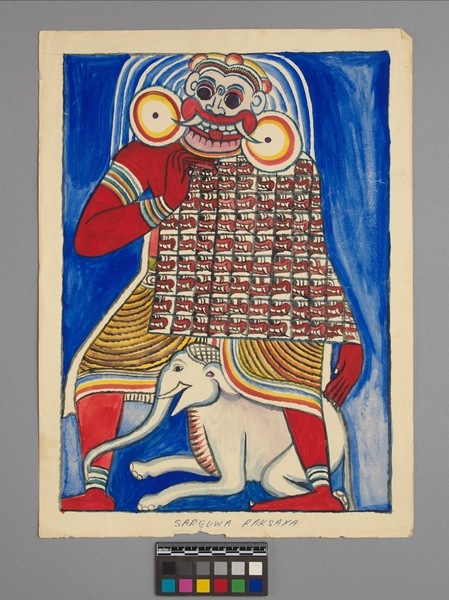Sarguwa Raksaya Item Number: 3392/16 from the MOA: University of British Columbia

Description
A watercolour painting which depicts a spiritual being with an elephant at its feet. The being has a white head and red body. It is wearing a yellow skirt that comes to an end just below the knee. The bottom of the skirt has a thick border made up of white, red, yellow and blue horizontal stripes. The main body of the skirt is covered in thinner horizontal stripes, and consists of two pieces which come together in the front. Decorative bands encircle the being's biceps, wrists, and ankles. A large piece of fabric is draped over the being's shoulder, covering most of its chest and arm. The fabric is decorated with a repeating pattern made out of squares. Each square contains part of an eye and half of a grinning, fanged mouth. The being has large, round eyes, red lips, and a grinning fanged mouth. It is wearing a headpiece with round decorations in the centre and on both sides. Two large discs protrude from the sides of its head. The elephant at the being's feet is kneeling, and its trunk is wrapped around the being's ankle. It has short tusks, a long tail, and is wearing a flat, white headpiece. The painting's background is blue, and a rectangular black border surrounds the image. Blue and white oblong rings radiate from the being's head and shoulders.
History Of Use
The imagery is possibly associated with ritual healing in Sri Lanka. The set of watercolours (3392/3-34) is said to depict spirits that inhabit planets, or deviyo (minor gods) or rakshas and yakkas (evil or mischievous beings). These beings are often depicted in masked dances and exorcisms.
Iconographic Meaning
Identified as a Raksha (demon)/Yakka; mischievous or evil.
Narrative
The collector, Dr. Michael Egan, wrote his doctoral thesis on healing rituals in Sri Lanka. His fieldwork was carried out in the south of Sri Lanka, in the village of Kadurupokuna (Hambantota District), between Sept. 1965 and Nov. 1966.
Item History
- Made in Sri Lanka between 1960 and 1966
- Collected between 1965 and 1966
- Owned by Michael John Egan before 1977
- Owned by Carol Egan before October 2, 2019
- Received from Carol Egan (Donor) on October 2, 2019
What
- Name
- Sarguwa Raksaya
- Identification Number
- 3392/16
- Type of Item
- painting
- Overall
- height 37.2 cm, width 27.3 cm
Who
- Culture
- Sinhalese
- Previous Owner
- Michael John Egan and Carol Egan
- Received from
- Carol Egan (Donor)
Where
- Holding Institution
- MOA: University of British Columbia
- Made in
- Sri Lanka
When
- Creation Date
- between 1960 and 1966
- Collection Date
- between 1965 and 1966
- Ownership Date
- before 1977 and before October 2, 2019
- Acquisition Date
- on October 2, 2019
Other
- Item Classes
- paintings; works on paper
- Condition
- good
- Accession Number
- 3392/0016